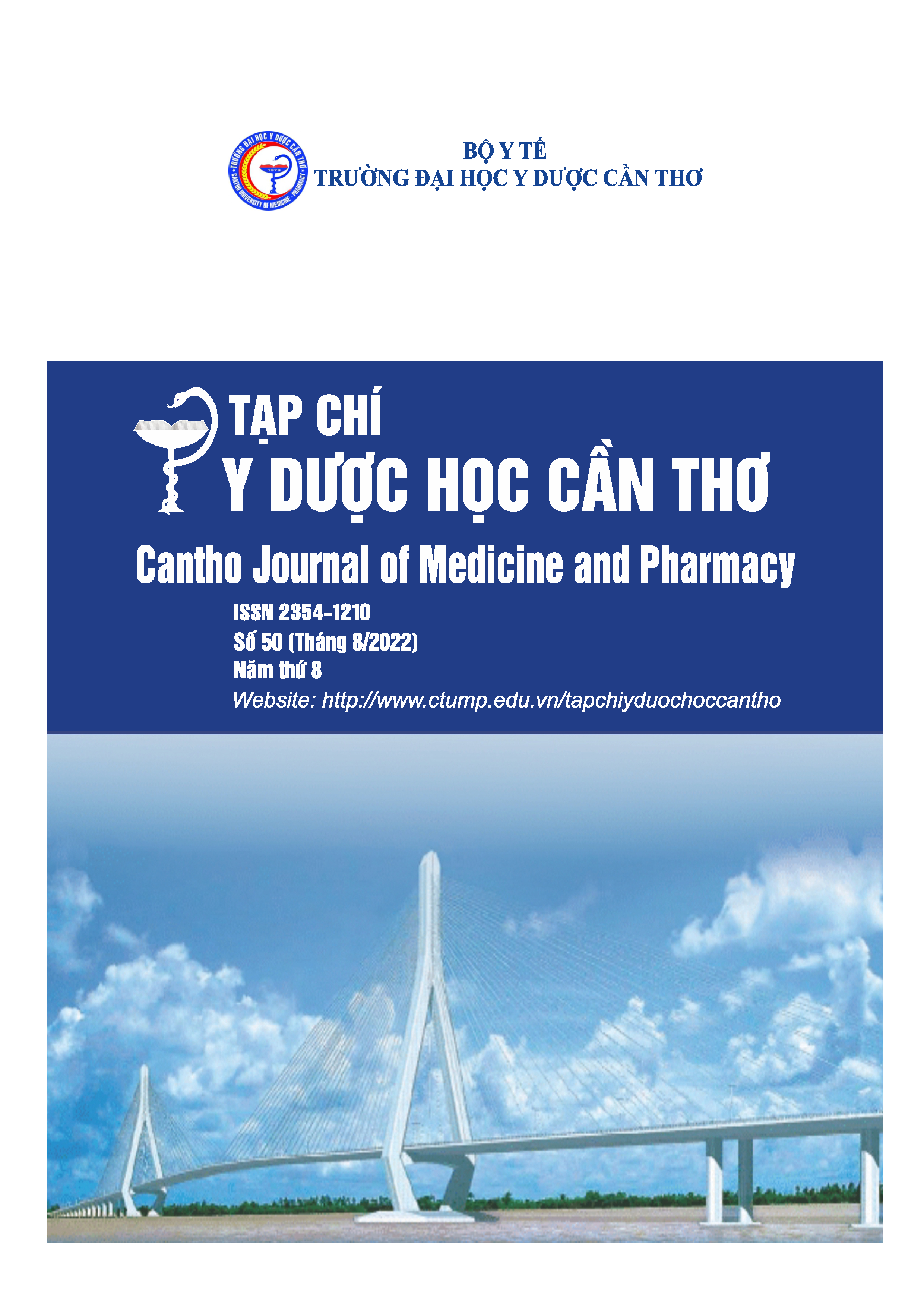STUDY ON THE CLINICAL, LABORATORY CHARACTERISTICS AND ASSESSMENT OF TREATMENT RESULTS OF CHRONIC RHINOSINUSITIS WITH MIDDLE NASAL SEPTUM POLYP BY ENDOSCOPIC SURGERY AT CAN THO OTOLARYNGOLOGY HOSPITAL IN 2021-2022
Main Article Content
Abstract
Background: Chronic rhinosinusitis with middle nasal septum polyp accounts for 4% of the population, and causes patients to decrease 36% of their efficiency and 38% of their labor productivity during the disease. Therefore, the effectiveness of treatment is worth concerning in these patients. Objectives: To describe the clinical, laboratory characteristics and the result of treatment in patients who suffer from chronic sinusitis with middle nasal septum polyp by endoscopic surgery at Can Tho Otolaryngology Hospital. Materials and methods: Report 63 cases have chronic sinusitis with middle nasal septum polyp examinations and treatments from March 2021 to March 2022 at Can Tho Otolaryngology Hospital. Results: In terms of clinical characteristics, nasal congestion (82.1%) was the most uncomfortable symptom that caused patients to be hospitalized. Besides, other characteristics were also recorded in patients including runny nose (95.2%); decreased or lost sense of smell (15.9%) and headache (93.7%). Regarding subclinical characteristics, large of patient have polyp in grade II (49.2%), grade III (39.7%), the rate of classification of sinusitis images on endoscopic was: grade I 9.5% ; grade II 47.6%; grade III 39.7% and grade IV 3.2%. For treatment, almost two methods were applied including opening the ethmoid and removing middle slit polyps (61.9%) and opening the middle slit, removing the ethmoid, frontal recess, sphenoid sinus and cutting middle slit polyps (30.2%), the average treatment time of 3 days or more gave a good 84.1% result after one month of treatment according to the EPOS 2020 standard. Conclusions: All patients have chronic sinusitis with middle nasal septum polyp had common symptoms including nasal congestion, runny nose and headache. The image of sinusitis before treatment was mostly in grades II and III. With the treatment method, 84.1% of patients had good results.
Article Details
Keywords
Chronic rhinosinusitis with middle nasal septum polyp
References
2. Lê Hành (2000), Bệnh polyp mũi xoang, bệnh sinh và cách chữa trị, Câu lạc bộ Viêm mũi xoang, 1 tháng 11/2000, tr.13-30.
3. Nguyễn Ngọc Liêm (2019), “Nghiên cứu đặc điểm lâm sàng, cận lâm sàng viêm đa xoang mạn tính và đánh giá kết quả điều trị bằng phẫu thuật nội soi mũi xoang tại Bệnh viện Tai Mũi Họng Cần Thơ năm 2018-2019”, Luận văn chuyên khoa cấp II, Trường Đại học Y Dược Cần Thơ.
4. Nguyễn Ngọc Minh (2015), “Phẫu thuật nội soi mũi xoang triệt để trong điều trị viêm mũi xoang mạn có polyp”, Chuyên đề Tai Mũi Họng và Phẫu thuật đầu cổ, tr.20-23.
5. Phan Đình Vĩnh Sang, Châu Chiêu Hòa, Dương Hữu Nghị (2017), “Nghiên cứu lâm sàng, cận lâm sàng và đánh giá kết quả phẫu thuật nội soi trên bệnh nhân viêm mũi xoang trước mạn tính tại bệnh viện Tai Mũi Họng Cần Thơ”, Tạp chí Y học thực hành, 5(1042), tr.27-29.
6. Đinh Tất Thắng, Hà Hoàng Tiên, Đỗ Thành Chung (2014), “Đánh giá kết quả điều trị viêm mũi xoang mạn tính bằng phẫu thuật nội soi mũi xoang tại Bệnh viện Đa khoa Quảng Ngãi”, Tạp chí Y học TP. Hồ Chí Minh, 18(1), tr.23-28.
7. Quách Võ Bích Thuận, Châu Chiêu Hòa, Dương Hữu Nghị (2018), “Đánh giá kết quả điều trịviêm mũi xoang mạn tính có polyp mũi bằng phẫu thuật nội soi mũi xoang tại bệnh viện Tai Mũi Họng năm 2015-2017”, Tạp chí Y Dược Học Cần Thơ, 11-12, tr.165-170.
8. Hồ Xuân Trung, Phan Văn Dưng, Nguyễn Tư Thế, Lê Thanh Thái (2017), “Đánh giá kết quảđiều trị viêm mũi xoang mạn tính có viêm xoang bướm bằng phẫu thuật nội soi chức năng mũi xoang”, Tạp chí Y Dược Học - Trường Đại học Y Dược Huế, 6(6), tr.114-121.
9. K. Larsen, M. Tos (1994), Clinical course of patients with primary nasal polyps, Acta Otolaryngol, 114 (5), pp.556-9.
10.L. Rudmik, T. L. Smith (2014), “Economic Evaluation of a Steroid-Eluting Sinus Implant following Endoscopic Sinus Surgery for Chronic Rhinosinusitis”, Otolaryngol Head Neck Surg, 151(2), pp.359-66.


